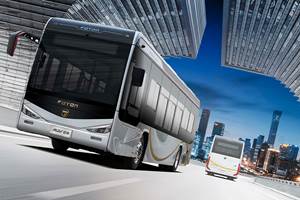On the radar: Innovations in composite battery enclosures
A look at recently reported design, material and process innovations for composites-intensive battery enclosures, developed to support the ramp-up of EV and AAM vehicles.
BOLDair is a composite battery enclosure design from Spanish Bold Valuable Technology developed specifically to meet the mechanical requirements and high-voltage needs of the aviation industry. Source | Bold Valuable Technology
Compared to gas-powered or hybrid vehicles, electric vehicles (EV) generally require much larger, heavier batteries, which in turn require larger, more flame-retardant (FR) battery enclosures to protect the rest of the vehicle in the case of a battery leak or thermal runaway event. At the same time, EV components generally need to be as lightweight as possible to both offset the extra battery weight and maximize vehicle range per charge.
Beyond automotive, electric vertical takeoff and landing (eVTOL) vehicles under development by a number of advanced air mobility (AAM) companies similarly require large batteries and lightweight but thermally protective battery enclosures.
These needs for design flexibility, the possibility of tuning for FR properties and lightweighting have all made fiber-reinforced composites key options for EV and eVTOL battery enclosures in recent years.
In support of new platforms and production ramp-ups, process and material innovations continue to be launched in this space, especially in regard to higher volume processes like injection molding or compression molding to meet greater demand needs, and developments toward increased material options like the use of thermoplastics versus thermoset composites, more FR additives and more.
Here are a few examples of developments reported recently by CW and its sister publications:
- High-performance battery specialist Bold Valuable Technology (Barcelona, Spain) has developed a high-voltage battery system called BOLDair catered to the needs of electric and hybrid aircraft. As CW contributing writer Stewart Mitchell reports, the BOLDair battery weighs only 52 kilograms and offers a specific energy of 285 watt-hours per kilogram. This performance is made possible through the use of advanced composite materials and construction techniques, principally the compression molded dual-skin carbon fiber-reinforced polymer (CFRP) monocoque battery housing.
-
One composite EV battery enclosure design showcased at the North American version of the Battery Show in Detroit, Michigan, this year was a prototype design developed by a collaboration of Forward Engineering (Royal Oak, Mich., U.S.), material supplier SABIC ((Riyadh, Saudi Arabia, and Houston, Texas, U.S.) and injection molding equipment supplier Engel (Schwertberg, Austria). As reported by Plastics Technology editor-in-chief Tony Deligio, the design consists of a three-piece structure, including an injection molded cover and tray affixed to a structural steel underbody panel. The top cover is composed of three primary elements in a sandwich design in which a 1.9-millimeter-thick layer of FR Stamax PP material is molded between two 0.3-millimeter organosheets inserted onto the A and B halves of the tool.
Engel, SABIC and Forward Engineering’s battery enclosure concept on display at the Battery Show in October 2024. The design includes built-in cooling channels and demonstrates a combination of high-volume injection molding with long glass fiber (LGF) reinforced polypropylene (PP) between organosheet layers. Source: CW
- At CAMX 2024, Cannon Ergos (Caronno Pertusella, Italy) displayed various capabilities for composite EV components, from bus panels to a battery enclosure cover designed with customer Senvias. The fiberglass/phenolic resin cover was made via wet compression molding and designed for maximum fire resistance (see video below).
- Following the Formnext 2024 trade show, Additive Manufacturing reported about 20% carbon fiber/ABS automotive battery covers 3D printed using a powerPrint large-format machine from KraussMaffei (Parsdorf, Germany). The final production parts will be molded, but the customer was able to quickly 3D print an initial run of parts for validation and qualification testing of the part design.
- Mito Material Solutions (Indianapolis, Ind., U.S.) is working on projects to incorporate its functionalized graphene materials into EV battery applications to reduce weight while increasing durability. Applications the company and its partners are looking at include battery pack adhesives and potentially composite battery enclosure components.
- Asahi Kasei (Tokyo, Japan) has introduced its Lastan nonwoven fabric as a flexible, flame-retardant material that can be used as extra thermal runaway protection for a variety of applications within an EV battery pack or laminated into a composite surface layer. This is said to be an alternative to heavier, more rigid mineral-based thermal runaway solutions.
- AAM company Archer Aviation Inc. (Santa Clara, Calif., U.S.) announced the completion of a high-volume battery pack manufacturing line, as well as new funding to support expansion and ramp-up of its electric powertrain facility.
Related Content
Composites end markets: Automotive (2024)
Recent trends in automotive composites include new materials and developments for battery electric vehicles, hydrogen fuel cell technologies, and recycled and bio-based materials.
Read MoreExel Composites supplies fiberglass profiles for Foton electric buses
Partnership with Chinese automotive manufacturer will see the implementation of pultruded profiles in various bus models, backed by weight savings, complex geometries and long life.
Read MoreSpanish startup to ramp up production of “recyclable” EV prototype
Liux’s BIG electric vehicle features multiple structural components manufactured via RTM from flax fabric and a thermoset resin said to enable the entire component to be recycled and reused again.
Read MoreComposites end markets: Batteries and fuel cells (2024)
As the number of battery and fuel cell electric vehicles (EVs) grows, so do the opportunities for composites in battery enclosures and components for fuel cells.
Read MoreRead Next
Büfa partners with Končar to develop composite electric rail platform
Končar-Električna to use Büfa fire-retardant composite materials for electric vehicle development.
Read MoreSMC composites progress BinC solar electric vehicles
In an interview with one of Aptera’s co-founders, CW sheds light on the inspiration behind the crowd-funded solar electric vehicle, its body in carbon (BinC) and how composite materials are playing a role in its design.
Read MoreFibreCoat secures up to €20 million for coatings maturation
Metal- and plastics-coated fiber innovator aims to rapidly grow radiation-, heat- and EMI-resistant material offerings for space and defense.
Read More
.jpg;width=70;height=70;mode=crop)


























